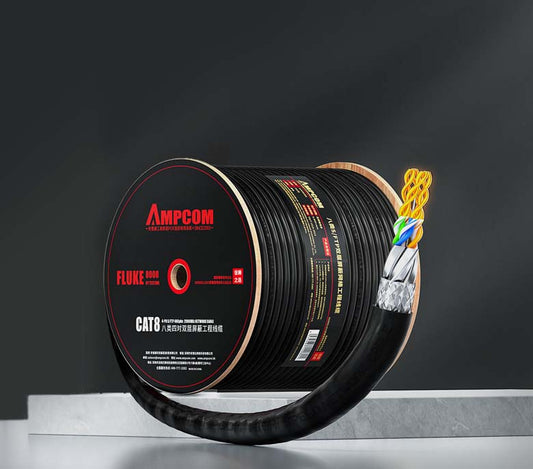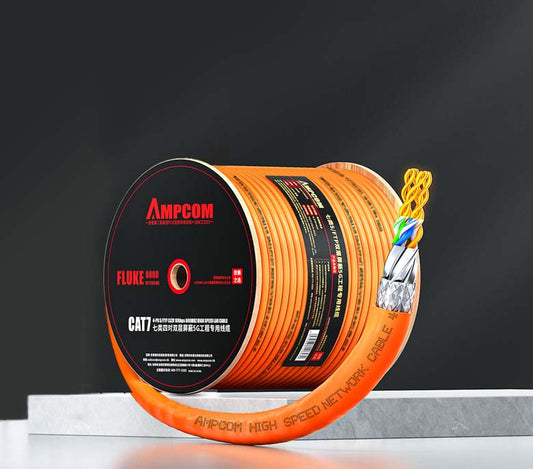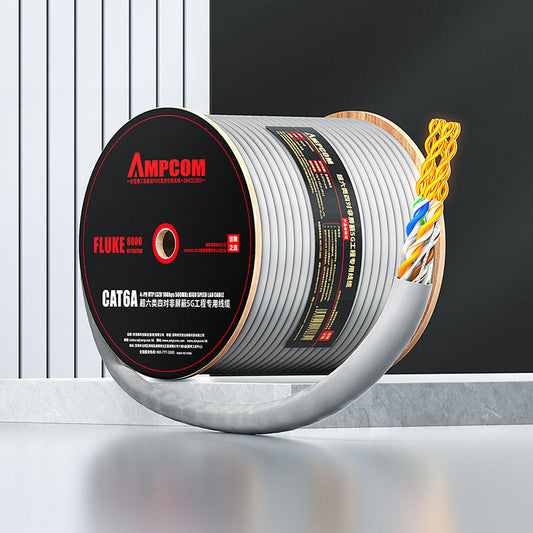Standards and Specifications: Installation Practices and Acceptance Criteria for Cat5e to Cat8 Patch Cables
Introduction: Network patch cables, as the fundamental physical medium connecting network devices and constructing network topologies, directly impact the overall performance and stability of the entire network. From the basic Cat5e to the high-performance Cat8, different categories of patch cables exhibit significant differences in transmission speed, frequency, and resistance to interference. However, simply purchasing compliant patch cables does not guarantee the construction of a high-performance network. The installation process is equally critical; any non-compliant operation can lead to performance degradation or even signal interruption. This document will delve into the installation practices for patch cables of various categories from Cat5e Patch Cable to Cat8 Patch Cable and elaborate in detail on the corresponding acceptance criteria, helping you ensure the quality of patch cable installations and fully leverage their performance potential.
From "Chaos" to "Order": The Importance and Best Practices of Data Center Cable Management

I. Pre-Installation Preparation: Planning and Inspection Successful patch cable installation begins with thorough preparation:
Needs Analysis and Planning:
Define the Application Scenario: First, determine the network environment where the patch cables will be used. Is it for home entertainment, small offices, large enterprise campuses, or high-performance computing centers? Different scenarios have varying requirements for patch cable categories and performance. For example, Cat5e Patch Cable is sufficient for short-distance 100BASE-TX and 1000BASE-T Ethernet needs, while Cat6a Patch Cable or Cat7 Patch Cable are more suitable for applications requiring stable 10 Gigabit speeds. Determine the Patch Cable Category: Select the appropriate patch cable category based on the requirements. Cat6 offers higher bandwidth and better resistance to interference compared to Cat5e, supporting Gigabit Ethernet over longer distances. Cat6a is an enhanced version of Cat6, specifically designed for 10 Gigabit Ethernet, with a frequency increase to 500 MHz. Cat7 and Cat7a provide higher shielding performance and bandwidth (600 MHz), while Cat8 targets high-speed 40G/100G applications, with frequencies up to 2000 MHz, but also imposes the highest requirements on the installation environment and device interfaces. Draw a Wiring Diagram: Before installation, create a detailed wiring diagram, marking the start point, end point, path, required patch cable length, device interface types, and other information. This helps avoid confusion and ensures orderly cabling. Environmental Check: Physical Path: Inspect the path the patch cables will traverse to ensure there are no sharp edges, excessively small bend radii (different categories of patch cables have different minimum bend radius requirements, with Cat8 being the most stringent), or other obstacles that could damage the cables. Electromagnetic Interference Sources: Assess whether there are strong electromagnetic interference sources in the environment, such as large motors, inverters, high-power wireless devices, etc. Patch cables with shielding (like F/UTP, S/FTP) for Cat7 and above have an advantage in resisting external interference, but during installation, they should still be kept as far away from interference sources as possible, and the shielding layer must be properly grounded. Temperature and Humidity: Check if the temperature and humidity of the installation environment are within the allowable range for the patch cable product. Tools and Materials Preparation: Patch Cables: Ensure the selected patch cable category, length, and color coding (if required) comply with the plan. Termination Tools: If on-site termination is needed (less common for patch cables, more for permanent links), prepare appropriate crimping tools, stripping tools, and wire cutting tools. For pre-terminated patch cables, mainly tools like fiber strippers (if it's a fiber patch cable) are needed. Testing Equipment: Prepare network cable testers that meet the standards of the patch cable category for performance verification after installation. For Cat6a and above, certified testers supporting higher frequencies and stricter test parameters may be required. Management Tools: Such as zip ties, cable management racks, label printers, label paper, etc., for patch cable organization and identification. Safety Protection: Wear necessary personal protective equipment, such as safety glasses and gloves.

II. Installation Practices for Different Categories of Patch Cables Although the basic installation principles are similar, different categories of patch cables have specific focuses in detail:
Cat5e Patch Cable Installation:
Termination: Typically uses RJ45 connectors. Follow the T568A or T568B wiring standard, ensuring consistency at both ends. The stripped length should be moderate, avoiding damage to the conductors or exposing too much twisted pair. Bend Radius: Maintain a radius greater than 4-6 times the cable diameter. Shielding: Cat5e is typically unshielded (UTP), so pay attention to avoiding proximity to strong interference sources.
Cat6 Patch Cable Installation:
Termination: Also uses RJ45 connectors, but with higher requirements for termination quality. The Cat6 core is thicker, and the untwisted length of the wire pairs must be strictly controlled, usually no more than 13mm, otherwise, crosstalk will be introduced. Using high-quality connectors and tools is crucial. Bend Radius: Usually requires a radius greater than 8 times the cable diameter. Shielding: Comes in unshielded (UTP) and shielded (F/UTP, S/FTP) versions. When installing shielded patch cables, pay special attention to the continuity of the shielding layer and proper grounding.
Cat6a Patch Cable Installation:
Termination: Cat6a has extremely strict requirements for termination quality. The untwisted length of wire pairs must strictly adhere to the standard (usually no more than 23mm), otherwise, Near-End Crosstalk (NEXT) and Return Loss will significantly exceed the limits. Recommended tools include punch-down tools or pre-terminated systems. Connectors are usually specially designed to accommodate thicker cores and higher performance requirements. Bend Radius: Requires a larger radius, typically more than 10 times the cable diameter. Shielding: Cat6a is almost always shielded (F/UTP or S/FTP). During installation, it is essential to ensure that the shielding layer is properly and reliably grounded at both ends to achieve the shielding effect and avoid ground loops. Typically, one end is grounded at the patch panel, and the other end is left floating (or handled according to specific device requirements).
Cat7/Cat7a Patch Cable Installation:
Termination: Cat7 was originally designed to use special connectors like GG-45 or TERA, but these connectors have not been widely adopted. Currently, more commonly used are RJ45-compatible connectors with shielding. During termination, in addition to controlling the untwisted length, ensure tight contact between the shielding layer and the connector's shielding shield. Cat7a has even stricter requirements. Bend Radius: Similar to or larger than Cat6a. Shielding: Usually fully shielded (S/FTP), meaning each pair of wires has independent shielding, and there is also an overall outer shield. During installation, the shielding layers at both ends must be completely and reliably grounded, usually grounded at both ends. Higher requirements for EMI protection in the installation environment.
Cat8 Patch Cable Installation:
Termination: Cat8 also primarily uses shielded RJ45 connectors. Termination precision requirements are extremely high, with strict regulations on untwisted wire pair lengths, conductor insertion depth, etc. It is recommended to use the highest-grade tools and certified termination personnel. Bend Radius: Requires the largest radius, typically 12 times or more the cable diameter. Shielding: Almost always fully shielded (S/FTP or SF/FTP, i.e., dual four-pair individual shielding plus overall shielding). Grounding the shielding layer is crucial, typically requiring reliable grounding at both ends. Extremely strict EMI control requirements for the installation environment; should be kept away from any potential interference sources. Special Requirements: Cat8 patch cables are typically used for short distances (e.g., within 30 meters for internal connections in data centers) and also have higher requirements for cable mechanical strength and durability.
Application and Customized Design of Cable Tracers in Specific Industries

III. Testing and Acceptance Criteria After Installation After installation, rigorous testing must be conducted to verify that the patch cables meet the design requirements:
Tester Selection:
Basic Testers: Can only verify continuity and basic wiring order, cannot detect performance parameters, suitable only for lower categories like Cat5e or non-critical applications. Certified Testers: Can measure and record multiple key performance parameters according to TIA or ISO standards and are essential tools for accepting qualified patch cable links. For Cat6a and above, testers supporting the corresponding category certification must be used.
Key Test Parameters:
Continuity: Verifies that all conductors are correctly connected, with no shorts, opens, misconnections, or reversals. Wiring Order: Confirms that the wiring order at both ends is consistent (T568A or T568B). Length: Measures the actual patch cable length to ensure it is within the planned range. Attenuation (Attenuation): The loss of signal as it travels through the cable. Lower values are better and must be below the limit specified by the standard. Near-End Crosstalk (NEXT): Interference caused by a signal transmitted on one pair to adjacent pairs. Higher values are better and must be above the standard limit. This is a key parameter affecting performance, with stricter requirements for higher Cat grades. Equal Level Far-End Crosstalk (ELFEXT): Far-end crosstalk considering the impact of attenuation, particularly important for long distances and high frequencies. Higher values are better. Return Loss (Return Loss): Loss caused by signal reflection at impedance mismatches in the cable (e.g., connectors, the cable itself). Higher values are better. Propagation Delay (Propagation Delay): The time it takes for a signal to travel a certain distance in the cable. Delay Skew (Delay Skew): The maximum difference in propagation delay among the four pairs. For high-speed applications (e.g., 10G and above), delay skew is particularly important and must be controlled within the standard range.
Acceptance Criteria:
Pass/Fail: Based on the tester's automatic judgment or manual comparison of test results against standard limits, determine whether each patch cable is qualified. Performance Grade: Test results not only determine pass/fail but also reflect the actual performance level of the patch cable. For example, a Cat6 patch cable might test results far exceeding the Cat6 standard, even approaching the Cat6a standard. Records and Reports: Detailed records should be kept for each tested and qualified patch cable, including start point, end point, length, test date, tester, and values for each parameter. Generate a test report as an important document for project acceptance and quality assurance. Sampling and Full Inspection: For critical applications or large projects, it may be necessary to conduct full inspection on all patch cables. For general applications, a certain percentage can also be sampled as needed.

IV. Common Installation Problems and Solutions
Problem: Performance does not meet standards, such as NEXT, ELFEXT, Return Loss parameters exceeding limits. Causes: Poor termination quality (excessive untwisting, poor crimping), poor connector quality, patch cable quality issues, improper shielding grounding, environmental interference, etc. Solutions: Re-terminate or replace connectors, replace qualified patch cables, check and properly ground the shielding layer, stay away from interference sources, improve installation techniques. Problem: Continuity faults (opens, shorts, misconnections). Causes: Termination errors, cable damage, connector damage. Solutions: Carefully inspect termination, replace cables or connectors. Problem: Patch cables are excessively bent or pulled. Causes: Non-compliant installation, poor management. Solutions: Follow minimum bend radius requirements, use appropriate patch cable management tools, avoid forceful operations.
Investment vs. Return: Evaluating the Value of Cat7/Cat8 Cables in Data Centers and HPC
V. Conclusion: Standardized Installation Ensures Network Reliability
The installation of network patch cables is not a simple "plug-and-play" process; it involves understanding standards, mastering tools, and paying attention to details. From Cat5e to Cat8, while the installation requirements for different categories of patch cables vary, the core principles—adhering to standards, focusing on details, and rigorous testing—are common. Only through standardized installation practices and strict acceptance testing can patch cables fully leverage their designed performance, laying a solid foundation for building a stable, high-speed, and reliable network environment. Neglecting installation quality, even with the highest-grade patch cables, can lead to the "barrel effect," significantly compromising the performance of the entire network system.



